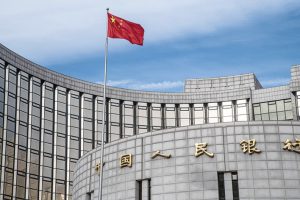BLOOMBERG
Chinese banks kept their benchmark lending rates unchanged on Monday despite the central bank’s surprise easing action last week, with economists betting there could be scope for lower rates in coming months.
Lenders held the one-year loan prime rate at 3.65% and left the five-year rate, a reference for mortgages, flat at 4.3%, according to a statement released by the People’s Bank of China (PBOC) in line. Almost all economists surveyed by Bloomberg had forecast the rates to be maintained.
The PBOC’s decision to lower the reserve requirement ratio for banks by 25 basis points, may give lenders room to reduce rates over time. The RRR cut will give lenders more cash they can use to disburse loans and help drive down banks’ funding costs.
UBS Group AG said there may be a 10 basis-point reduction in loan prime rates in the remainder of 2023, “which could
help lower the actual funding cost for the real economy and mortgage rates.â€
The steady fixings for China’s loan prime rates on Monday are in line with expectations, given the People’s Bank of China’s hold on its key interest rate. But the PBOC’s decision to reduce banks’ required reserves highlights an easing stance. “We expect the PBOC to cut rates in Q2 2023, which should prompt banks to lower their LPRs,†an analyst said.
The RRR cut — which will take effect from March 27 — caught many analysts off-guard as it wasn’t telegraphed by the State Council, China’s cabinet, ahead of time — as had been the case for the previous two reductions last year.
The PBOC’s move came days after a new leadership was ushered in at the National People’s Congress, the annual parliamentary gathering, and where the government outlined its economic goals for the year, including a gross domestic product target of around 5%.
The Economic Daily, a newspaper affiliated with the State Council, said in a commentary the RRR cut sends a “clear signal†that the authorities intend to guide financial institutions to better stabilise growth, expand domestic demand and consolidate the recovery. The PBOC’s action comes against the backdrop of heightened turmoil in financial markets, triggered by a global banking crisis, as well as a still-uncertain recovery in China’s economy.
The PBOC said the cut in the reserve ratio was aimed at maintaining “reasonable and sufficient liquidity†and ensuring that money supply increases in line with nominal economic growth.
The central bank added it won’t engage in “flood irrigation,†a term it uses to refer to large stimulus.
“The economic data is not as good as expected,†said Iris Pang, chief economist for China at ING Groep NV. The RRR cut could “help to lower market interest rates, which could help to lower bond issuance interest costs. This may benefit real estate property developers and local government financial vehicles for their funding needs,†she said.
A supplementary reason could be “to provide a cushion against any potential negative impact from global market turmoil,†she said.
The PBOC said the cut in the reserve ratio was aimed at maintaining “reasonable and sufficient liquidity†and ensuring that money supply increases in line with nominal economic growth. The central bank added it won’t engage in “flood irrigation,†a term it uses to refer to large stimulus.
 The Gulf Time Newspaper One of the finest business newspapers in the UAE brought to you by our professional writers and editors.
The Gulf Time Newspaper One of the finest business newspapers in the UAE brought to you by our professional writers and editors.
